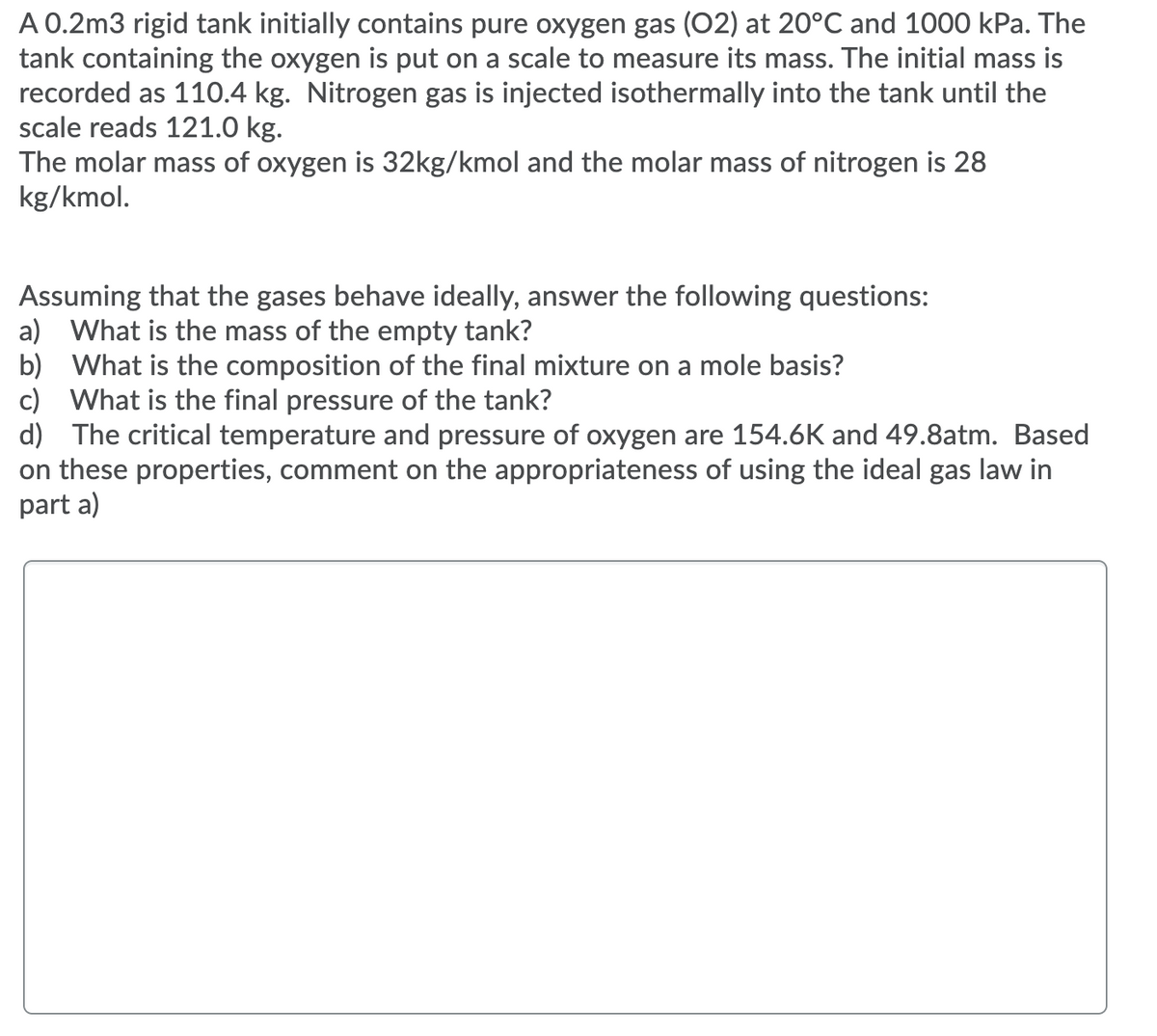A 0.2m3 rigid tank initially contains pure oxygen gas (02) at 20°C and 1000 kPa. The tank containing the oxygen is put on a scale to measure its mass. The initial mass is recorded as 110.4 kg. Nitrogen gas is injected isothermally into the tank until the scale reads 121.0 kg. The molar mass of oxygen is 32kg/kmol and the molar mass of nitrogen is 28 kg/kmol. Assuming that the gases behave ideally, answer the following questions: a) What is the mass of the empty tank? b) What is the composition of the final mixture on a mole basis? c) What is the final pressure of the tank?
A 0.2m3 rigid tank initially contains pure oxygen gas (02) at 20°C and 1000 kPa. The tank containing the oxygen is put on a scale to measure its mass. The initial mass is recorded as 110.4 kg. Nitrogen gas is injected isothermally into the tank until the scale reads 121.0 kg. The molar mass of oxygen is 32kg/kmol and the molar mass of nitrogen is 28 kg/kmol. Assuming that the gases behave ideally, answer the following questions: a) What is the mass of the empty tank? b) What is the composition of the final mixture on a mole basis? c) What is the final pressure of the tank?
Chemistry
10th Edition
ISBN:9781305957404
Author:Steven S. Zumdahl, Susan A. Zumdahl, Donald J. DeCoste
Publisher:Steven S. Zumdahl, Susan A. Zumdahl, Donald J. DeCoste
Chapter1: Chemical Foundations
Section: Chapter Questions
Problem 1RQ: Define and explain the differences between the following terms. a. law and theory b. theory and...
Related questions
Question

Transcribed Image Text:A 0.2m3 rigid tank initially contains pure oxygen gas (02) at 20°C and 1000 kPa. The
tank containing the oxygen is put on a scale to measure its mass. The initial mass is
recorded as 110.4 kg. Nitrogen gas is injected isothermally into the tank until the
scale reads 121.0 kg.
The molar mass of oxygen is 32kg/kmol and the molar mass of nitrogen is 28
kg/kmol.
Assuming that the gases behave ideally, answer the following questions:
a) What is the mass of the empty tank?
b) What is the composition of the final mixture on a mole basis?
c) What is the final pressure of the tank?
d) The critical temperature and pressure of oxygen are 154.6K and 49.8atm. Based
on these properties, comment on the appropriateness of using the ideal gas law in
part a)
Expert Solution
This question has been solved!
Explore an expertly crafted, step-by-step solution for a thorough understanding of key concepts.
Step by step
Solved in 2 steps with 1 images

Knowledge Booster
Learn more about
Need a deep-dive on the concept behind this application? Look no further. Learn more about this topic, chemistry and related others by exploring similar questions and additional content below.Recommended textbooks for you

Chemistry
Chemistry
ISBN:
9781305957404
Author:
Steven S. Zumdahl, Susan A. Zumdahl, Donald J. DeCoste
Publisher:
Cengage Learning

Chemistry
Chemistry
ISBN:
9781259911156
Author:
Raymond Chang Dr., Jason Overby Professor
Publisher:
McGraw-Hill Education

Principles of Instrumental Analysis
Chemistry
ISBN:
9781305577213
Author:
Douglas A. Skoog, F. James Holler, Stanley R. Crouch
Publisher:
Cengage Learning

Chemistry
Chemistry
ISBN:
9781305957404
Author:
Steven S. Zumdahl, Susan A. Zumdahl, Donald J. DeCoste
Publisher:
Cengage Learning

Chemistry
Chemistry
ISBN:
9781259911156
Author:
Raymond Chang Dr., Jason Overby Professor
Publisher:
McGraw-Hill Education

Principles of Instrumental Analysis
Chemistry
ISBN:
9781305577213
Author:
Douglas A. Skoog, F. James Holler, Stanley R. Crouch
Publisher:
Cengage Learning

Organic Chemistry
Chemistry
ISBN:
9780078021558
Author:
Janice Gorzynski Smith Dr.
Publisher:
McGraw-Hill Education

Chemistry: Principles and Reactions
Chemistry
ISBN:
9781305079373
Author:
William L. Masterton, Cecile N. Hurley
Publisher:
Cengage Learning

Elementary Principles of Chemical Processes, Bind…
Chemistry
ISBN:
9781118431221
Author:
Richard M. Felder, Ronald W. Rousseau, Lisa G. Bullard
Publisher:
WILEY